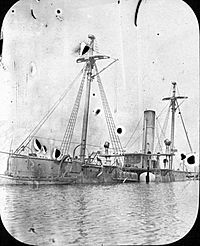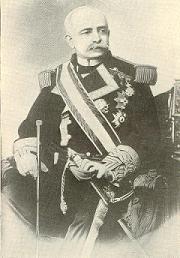Patricio Montojo y Pasarón facts for kids
Quick facts for kids
Patricio Montojo
|
|
|---|---|
 |
|
| Nickname(s) | "The fighting Montojo" |
| Born | September 7, 1839 Ferrol, Province of A Coruña, Spain |
| Died | September 30, 1917 (aged 78) Madrid, Community of Madrid, Spain |
| Allegiance | |
| Service/ |
|
| Years of service | 1855–1899 |
| Rank | (Rear Admiral) |
| Commands held | Pacific Squadron |
| Battles/wars | Chincha Islands War |
Rear Admiral Patricio Montojo y Pasarón (born September 7, 1839 – died September 30, 1917) was a Spanish naval officer. He led Spain's Pacific Squadron, which was based in the Philippines, during the Spanish–American War. Montojo was known for his skill and experience. He faced the tough job of defending the Spanish Philippines with a small navy and limited supplies. He was up against a much larger U.S. Asiatic Squadron.
Despite his bravery, Montojo's navy was defeated at the important Battle of Manila Bay by U.S. Navy Commodore George Dewey. After the defeat, Montojo was blamed and faced a court-martial (a military trial) in Spain. Even though the decision was later changed, Montojo was still removed from the Spanish Navy.
Contents
Patricio Montojo was born in Ferrol, a city in Galicia, Spain. He began his naval training at the Naval School in Cádiz in 1855. By 1860, he became a sublieutenant. He fought against the Moros (a group of people) in Mindanao, Philippines. He then returned to Spain in 1864. While in the Philippines, Montojo also visited China and the French colony in southern Vietnam.
Montojo fought in the Battle of Abtao and the Battle of El Callao. These battles were part of the Chincha Islands War against Peru. He later worked at the Secretariat of the Admiralty. In 1873, he was promoted to Commander. His new duties included leading warships in Havana and the Río de la Plata. Montojo stayed in Madrid until 1891, when he became a flag officer. In 1892, he was considered for the Order of Isabella the Catholic. In 1897, he received the Military Order of María Cristina.
Service in the Philippines

By 1898, Montojo returned to the Philippines as a rear admiral. He was the general commander of all Spanish naval stations there. He also took part in actions against Filipino rebels. On March 15, 1898, he met with the colony's governor-general, Basilio Augustín. Montojo shared his worries that their forces would be destroyed by the Americans. War with the United States seemed very likely.
Of Spain's 37 ships in the Philippines, most were small gunboats. Only seven ships could fight the U.S. Asiatic Squadron. The Spanish forces also lacked enough good mines. Some of the mines they had were missing parts. Montojo asked for more supplies from Spain, but they never arrived. Montojo decided to send his squadron to Subic Bay, northwest of Manila. He thought it would be easier to defend there. If the Americans ignored them and went to Manila, he planned to ambush them at night.
However, when the Americans arrived at Subic on April 30, they found no Spanish ships. Montojo had decided the position was too hard to defend. The Spaniards were behind schedule and had not finished setting up naval guns at the bay's entrance. American scouts said the guns were on the beach and could have been set up quickly. Also, the wooden cruiser Castilla had mechanical problems. So, the Spanish captains decided to return to Manila Bay. Montojo also thought he couldn't save his sailors in the deep waters of Subic. American naval officers were surprised by this decision.
The American ships entered Manila Bay without hitting the few mines Spain had placed. The water was too deep, and the waterway was too wide for the mines to be useful. Aside from some artillery fire from Corregidor island, the Americans met little resistance. They entered the bay safely. The Spanish ships were anchored near the naval base at Cavite. Montojo, feeling pessimistic about the battle, believed his men would have the best chance of survival there.
The battle that followed was Montojo's first major naval fight in over 30 years. The U.S. squadron reached Cavite and attacked the Spanish on May 1, 1898, around 5:00 in the morning. By 5:40, none of the U.S. ships were damaged, despite fire from shore and Montojo's squadron. The American squadron fired back. Montojo's flagship, the cruiser Reina Cristina, was badly damaged. The other Spanish ships also suffered heavy damage. Montojo had to move his flag to the Isla de Cuba. A British ship captain passing by noted Montojo's bravery. He said Montojo "stood upright in the stern perfectly unmoved."
By 7:30 in the morning, the Asiatic Squadron pulled back to get more ammunition and let the crew rest. Only eight Americans were wounded on the USS Baltimore, and one died on the USS McCulloch. After about three and a half hours, around 11:15 a.m., the American ships returned. By then, much of the Spanish squadron was destroyed. Resistance was limited, and soon after, the Spaniards surrendered. Montojo reported about 381 casualties for his squadron. One of his two sons was among the wounded.
Later Life and Legacy
After the defeat at Manila Bay, Rear Admiral Montojo was called back to Madrid. He was made a scapegoat (someone blamed for something) for the loss. He faced a court-martial despite the difficult situation he was in. He left Manila in October and arrived in Spain in November 1898. In March 1899, he was imprisoned by the court-martial's order, but he was later released.
Admiral George Dewey, the American officer who defeated Montojo, even spoke in his defense. Montojo had sent Dewey a letter asking for help. Dewey replied, "your defense at Cavite was gallant in the extreme. The fighting of your flagship... was especially worthy of a place in the traditions of valor of your nation." Montojo was later cleared of the charges. However, he was still discharged from the Spanish Navy. In June 2017, a screenplay was written about Montojo's court-martial and Admiral Dewey's help.
Patricio Montojo died in Madrid on September 30, 1917.
Personal Interests
Montojo was also a writer. He wrote several books and articles for different publications. Some of his works include León Aldao, A Critical Essay on the First Lands Discovered by Columbus, and Encyclopedic Nautical Handbook. He also translated books, like Angelo Secchi's physics book and The Two Admirals by James Fenimore Cooper.
One of his daughters, Fermina Montojo Torrontegui, married Enrique Zóbel de Ayala. Their son, and Montojo's grandson, Fernando Zobel de Ayala, became a famous modern Filipino-Spanish painter.
Awards
![]() Grand Cross of the Order of Isabella the Catholic (Spain)
Grand Cross of the Order of Isabella the Catholic (Spain)
![]() Military Order of María Cristina (Spain)
Military Order of María Cristina (Spain)
See also
 In Spanish: Patricio Montojo y Pasarón para niños
In Spanish: Patricio Montojo y Pasarón para niños



